What are control statements in java?
Java Control Statements:
The Java control statements inside a program are usually
executed sequentially. Sometimes a programmer wants to break the normal flow
and jump to another statement or execute a set of statements repeatedly. The
statements which break the normal sequential flow of the program are called
control statements. A control statement enables decision making, looping and
branching.
Decision Making Statements:
These statements decide the flow of the execution based on
some conditions.
- If then
- If then else
- switch
if Statement:
The Java if statement tests the condition. It executes
the if block if condition is true.
Syntax:
if(condition){
//code to be executed
}
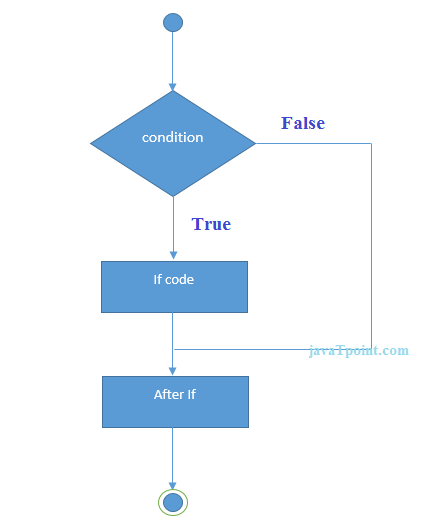
Example:
//Java Program to demonstate the use of if statement.
public class IfExample {
public static void main(String[] args) {
//defining an 'age' variable
int age=20;
//checking the age
if(age>18){
System.out.print("Age is greater than 18");
}
}
}
Output:
Age is greater than 18
if-else Statement
The Java if-else statement also tests the condition. It
executes the if block if condition is true otherwise else
block is executed.
Syntax:
if(condition){
//code if condition is true
}else{
//code if condition is false
}
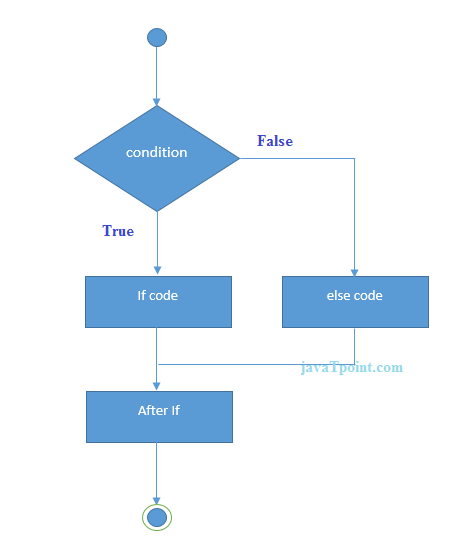
Example:
//A Java Program to demonstrate the use of if-else statement.
//It is a program of odd and even number.
public class IfElseExample {
public static void main(String[] args) {
//defining a variable
int number=13;
//Check if the number is divisible by 2 or not
if(number%2==0){
System.out.println("even number");
}else{
System.out.println("odd number");
}
}
}
Output:
odd number
if-else-if ladder Statement
The if-else-if ladder statement executes one condition
from multiple statements.
Syntax:
if(condition1){
//code to be executed if condition1 is true
}else if(condition2){
//code to be executed if condition2 is true
}
else if(condition3){
//code to be executed if condition3 is true
}
...
else{
//code to be executed if all the conditions are false
}
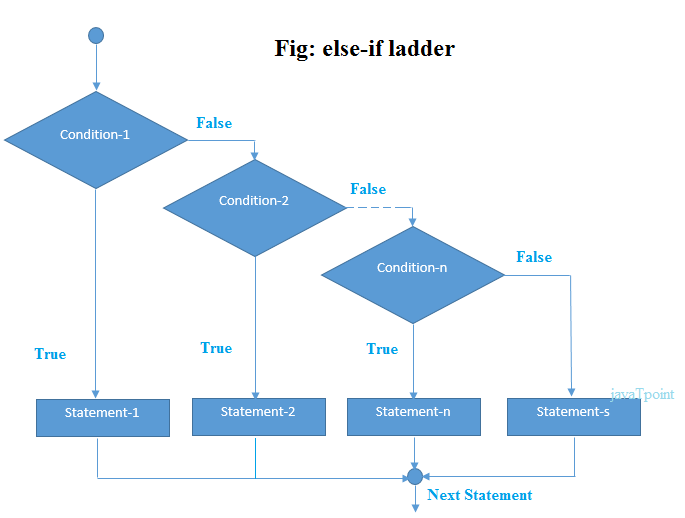
Example:
//Java Program to demonstrate the use of If else-if ladder.
//It is a program of grading system for fail, D grade, C grade, B grade, A grade and A+.
public class IfElseIfExample {
public static void main(String[] args) {
int marks=65;
if(marks<50){
System.out.println("fail");
}
else if(marks>=50 && marks<60){
System.out.println("D grade");
}
else if(marks>=60 && marks<70){
System.out.println("C grade");
}
else if(marks>=70 && marks<80){
System.out.println("B grade");
}
else if(marks>=80 && marks<90){
System.out.println("A grade");
}else if(marks>=90 && marks<100){
System.out.println("A+ grade");
}else{
System.out.println("Invalid!");
}
}
}
Output:
C grade
Nested if statement
The nested if statement represents the if block
within another if block. Here, the inner if block condition executes only
when outer if block condition is true.
Syntax:
if(condition){
//code to be executed
if(condition){
//code to be executed
}
}

Example:
//Java Program to demonstrate the use of Nested If Statement.
public class JavaNestedIfExample {
public static void main(String[] args) {
//Creating two variables for age and weight
int age=20;
int weight=80;
//applying condition on age and weight
if(age>=18){
if(weight>50){
System.out.println("You are eligible to donate blood");
}
}
}}
Output:
You are eligible to donate blood
Switch Statement
The switch statement is a multi way branch statement. It
provides an easy way to dispatch execution to different parts of code based on
the value of the expression.
Syntax:
Syntax:
switch (expression)
{
case value1:
statement1;
break;
case value2:
statement2;
break;
.
.
case valueN:
statementN;
break;
default:
statementDefault;
}
Points to Remember
- There can be one or N number of case values for a switch expression.
- The case value must be of switch expression type only. The case value must be literal or constant. It doesn't allow variables.
- The case values must be unique. In case of duplicate value, it renders compile-time error.
- The Java switch expression must be of byte, short, int, long (with its Wrapper type), enums and string.
- Each case statement can have a break statement which is optional. When control reaches to the break statement, it jumps the control after the switch expression. If a break statement is not found, it executes the next case.
- The case value can have a default label which is optional.
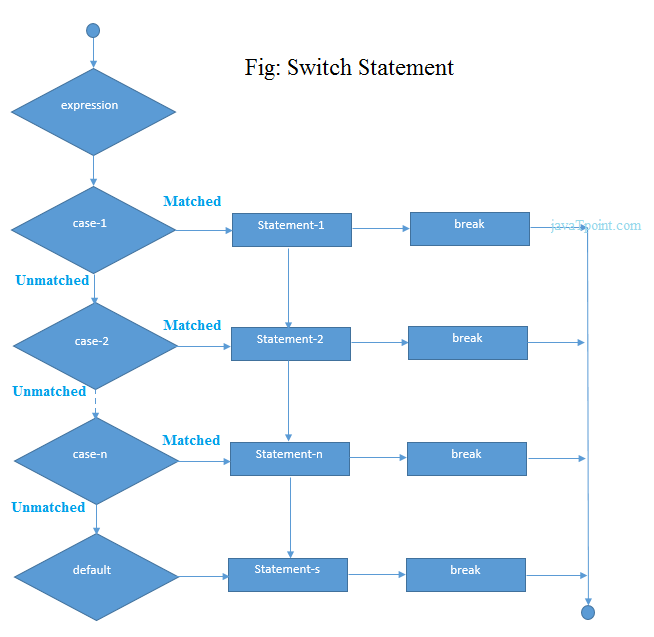
Example:
public class SwitchExample {
public static void main(String[] args) {
//Declaring a variable for switch expression
int number=20;
//Switch expression
switch(number){
//Case statements
case 10: System.out.println("10");
break;
case 20: System.out.println("20");
break;
case 30: System.out.println("30");
break;
//Default case statement
default:System.out.println("Not in 10, 20 or 30");
}
}
}
Output:
20
Switch Statement is fall-through
The Java switch statement is fall-through. It means it
executes all statements after the first match if a break statement is not
present.
Example:
//Java Switch Example where we are omitting the
//break statement
public class SwitchExample2 {
public static void main(String[] args) {
int number=20;
//switch expression with int value
switch(number){
//switch cases without break statements
case 10: System.out.println("10");
case 20: System.out.println("20");
case 30: System.out.println("30");
default:System.out.println("Not in 10, 20 or 30");
}
}
}
Output:
20
30
Not in 10, 20 or 30
Nested Switch Statement
We can use switch statement inside other switch statement
in Java. It is known as nested switch statement.
Example:
//Java Program to demonstrate the use of Java Nested Switch
public class NestedSwitchExample {
public static void main(String args[])
{
//C - CSE, E - ECE, M - Mechanical
char branch = 'C';
int collegeYear = 4;
switch( collegeYear )
{
case 1:
System.out.println("English, Maths, Science");
break;
case 2:
switch( branch )
{
case 'C':
System.out.println("Operating System, Java, Data Structure");
break;
case 'E':
System.out.println("Micro processors, Logic switching theory");
break;
case 'M':
System.out.println("Drawing, Manufacturing Machines");
break;
}
break;
case 3:
switch( branch )
{
case 'C':
System.out.println("Computer Organization, MultiMedia");
break;
case 'E':
System.out.println("Fundamentals of Logic Design, Microelectronics");
break;
case 'M':
System.out.println("Internal Combustion Engines, Mechanical Vibration");
break;
}
break;
case 4:
switch( branch )
{
case 'C':
System.out.println("Data Communication and Networks, MultiMedia");
break;
case 'E':
System.out.println("Embedded System, Image Processing");
break;
case 'M':
System.out.println("Production Technology, Thermal Engineering");
break;
}
break;
}
}
}
Output:
Data Communication and Networks, MultiMedia
LOOPS:
Statements inside a loop are executed repeatedly provided
with some condition which terminates the loop.
- for
- while
- do while
For Loop
The Java for loop is used to iterate a part
of the program several times. If the number of iteration is fixed, it is
recommended to use for loop.
There are three types of for loops in java.
·
Simple For Loop
·
For-each or Enhanced For Loop
·
Labeled For Loop
Simple For Loop
A simple for loop is the same as C/C++. We can initialize
the variable, check condition and increment/decrement value. It consists of
four parts:
- Initialization: It is the initial condition which is executed once when the loop starts. Here, we can initialize the variable, or we can use an already initialized variable. It is an optional condition.
- Condition: It is the second condition which is executed each time to test the condition of the loop. It continues execution until the condition is false. It must return boolean value either true or false. It is an optional condition.
- Statement: The statement of the loop is executed each time until the second condition is false.
- Increment/Decrement: It increments or decrements the variable value. It is an optional condition.
Syntax:
for(initialization;condition;incr/decr){
//statement or code to be executed
}
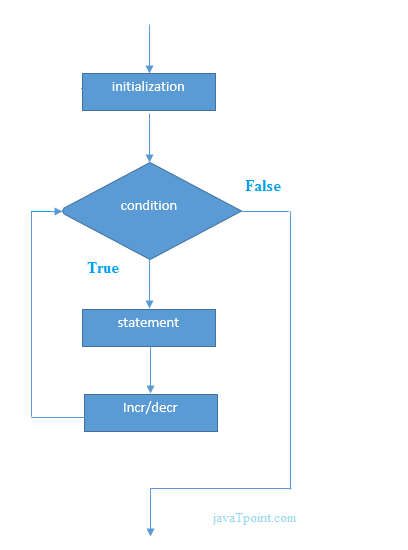
Example:
//Java Program to demonstrate the example of for loop
//which prints table of 1
public class ForExample {
public static void main(String[] args) {
//Code of Java for loop
for(int i=1;i<=10;i++){
System.out.println(i);
}
}
}
Output:
1
2
3
4
5
6
7
8
9
10
If we have a for loop inside the another loop, it is known
as nested for loop. The inner loop executes completely whenever outer loop
executes.
Example:
public class NestedForExample {
public static void main(String[] args) {
//loop of i
for(int i=1;i<=3;i++){
//loop of j
for(int j=1;j<=3;j++){
System.out.println(i+" "+j);
}//end of i
}//end of j
}
}
Output:
1 1
1 2
1 3
2 1
2 2
2 3
3 1
3 2
3 3
The for-each loop is used to traverse array or collection in
java. It is easier to use than simple for loop because we don't need to
increment value and use subscript notation.
It works on elements basis not index. It returns element one
by one in the defined variable.
Syntax:
for(Type var:array){
//code to be executed
}
Example:
//Java For-each loop example which prints the
//elements of the array
public class ForEachExample {
public static void main(String[] args) {
//Declaring an array
int arr[]={12,23,44,56,78};
//Printing array using for-each loop
for(int i:arr){
System.out.println(i);
}
}
}
Output:
12
23
44
56
78
While loop:
A while loop is a control flow statement that allows
code to be executed repeatedly based on a given Boolean condition. The while
loop can be thought of as a repeating if statement.
Syntax:
while (boolean condition)
{
loop statements...
}
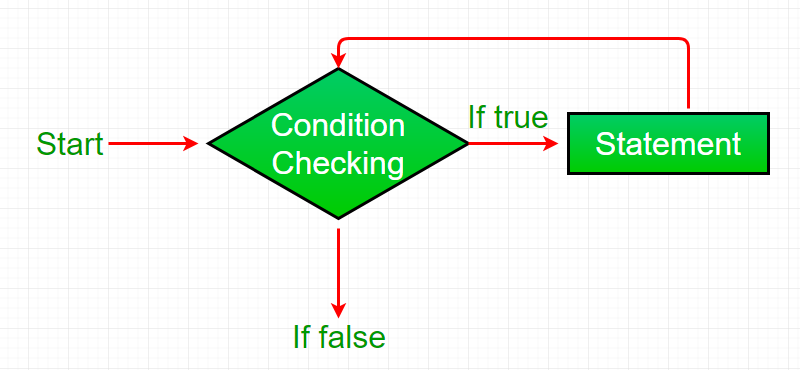
- While loop starts with the checking of condition. If it evaluated to true, then the loop body statements are executed otherwise first statement following the loop is executed. For this reason it is also called Entry control loop
- Once the condition is evaluated to true, the statements in the loop body are executed. Normally the statements contain an update value for the variable being processed for the next iteration.
- When the condition becomes false, the loop terminates which marks the end of its life cycle.
Example:
public class WhileExample {
public static void main(String[] args) {
int i=1;
while(i<=10){
System.out.println(i);
i++;
}
}
}
Output:
1
2
3
4
5
6
7
8
9
10
do while loop:
do while loop is similar to while loop with only
difference that it checks for condition after executing the statements, and
therefore is an example of Exit Control Loop.
Syntax:
do
{
statements..
}
while (condition);
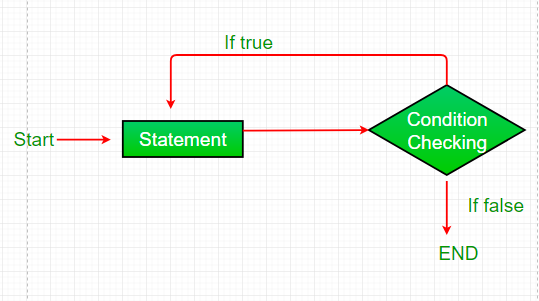
- do while loop starts with the execution of the statement(s). There is no checking of any condition for the first time.
- After the execution of the statements, and update of the variable value, the condition is checked for true or false value. If it is evaluated to true, next iteration of loop starts.
- When the condition becomes false, the loop terminates which marks the end of its life cycle.
- It is important to note that the do-while loop will execute its statements at least once before any condition is checked, and therefore is an example of exit control loop.
Example:
public class DoWhileExample {
public static void main(String[] args) {
int i=1;
do{
System.out.println(i);
i++;
}while(i<=10);
}
}
Output:
1
2
3
4
5
6
7
8
9
10
Branching Statements
Branching statements are used to jump from the current executing loop.
- break
- continue
- return
Break:
The break statement is a branching statement that contains two forms: labeled and unlabeled. The break statement is used for breaking the execution of a loop (while, do-while and for) . It also terminates the switch statements.
Syntax:
break; // breaks the innermost loop or switch statement.
break label; // breaks the outermost loop in a series of nested loops.
Continue statements: This is a branching statement that are used in the looping statements (while, do-while and for) to skip the current iteration of the loop and resume the next iteration .
Syntax:
continue;
Return statements: It is a special branching statement that transfers the control to the caller of the method. This statement is used to return a value to the caller method and terminates execution of method. This has two forms: one that returns a value and the other that can not return. the returned value type must match the return type of method.
Syntax:
break; // breaks the innermost loop or switch statement.
break label; // breaks the outermost loop in a series of nested loops.
Continue statements: This is a branching statement that are used in the looping statements (while, do-while and for) to skip the current iteration of the loop and resume the next iteration .
Syntax:
continue;
Return statements: It is a special branching statement that transfers the control to the caller of the method. This statement is used to return a value to the caller method and terminates execution of method. This has two forms: one that returns a value and the other that can not return. the returned value type must match the return type of method.
Syntax:
return;
return values;
return;
return values;
return; //This returns nothing. So this can be used when method is declared with void return type.
return expression; //It returns the value evaluated from the expression.
return expression; //It returns the value evaluated from the expression.

Comments
Post a Comment